Apple iPhone 12 mini review: For small phone fans only
I love this phone, but I can't trust its battery.
The tech industry is obsessed with size, and it's easy to see why. "Bigger" is often used as shorthand for "better," and if you need proof just look at phones. They haven't just become faster and more capable; they've also become enormous. That's not to say good small phones are impossible to find — Google’s standard-issue Pixels are pretty great, and Sony made a beautifully tiny Xperia a few years ago — but they're not nearly as common as they once were. Now, with the iPhone 12 mini, Apple is mounting a small-smartphone comeback.
Between its refreshed design, A14 Bionic chipset, 5G support and camera setup, the mini is mostly the same as the iPhone 12, except it’s more compact and costs $100 less. At a time where we’re spending more time at home surrounded by big screens, and people are more sensitive to price, a small but powerful iPhone could be just the ticket. After living with one for a week, though, I'm torn. Though I love the iPhone 12 mini, I would never buy one for myself, and wouldn't recommend it to most people.
Configurations
The iPhone 12 mini is Apple's smallest flagship phone in years, and if you're thinking of buying one, you have some decisions to make. Apart from the many color options, the biggest choice is how much storage you need:
64GB: $699/$729
128GB: $749/$779
256GB: $849/$879
Why the different prices, you say? It all boils down to where you buy your phone. If you get a carrier-locked iPhone 12 mini straight from Apple, you'll spend $30 less than if you bought the equivalent unlocked model. The phones also cost less when you buy them directly from AT&T or Verizon, but not T-Mobile/Sprint. (Note: Apple has never offered a satisfying answer about these price differences.)
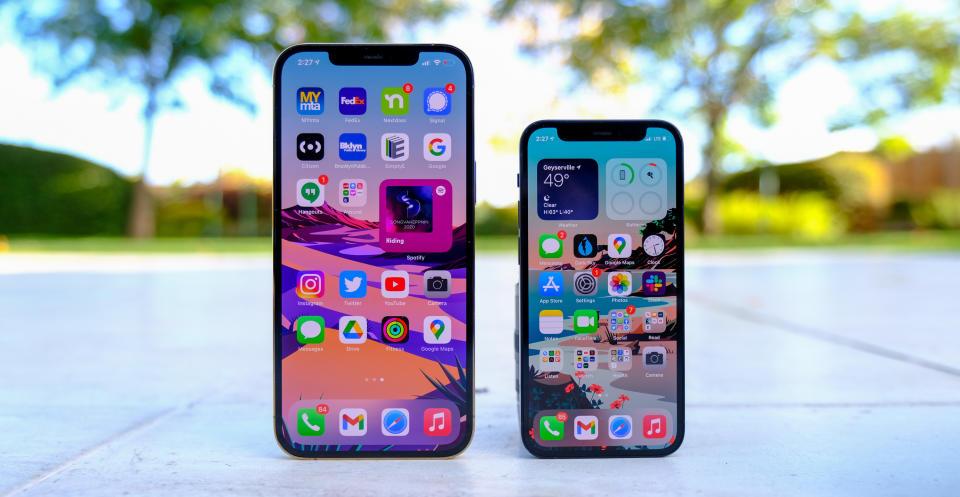
The same, but smaller
I just reviewed the iPhone 12 a couple weeks ago, so forgive me if I repeat myself a little. As I said earlier, the 12 and 12 mini are mostly the same phone — and that’s mostly great.
For one, Apple's smallest new iPhone is just as fast as its big brother thanks to that A14 Bionic chipset. I could rehash out how Apple's shift to 5nm chips gave it the transistor budget needed to significantly boost its processors' performance, but it’s not really necessary. Long story short, the iPhone 12 mini is lightning-fast, whether you're playing resource-intensive games or bouncing between multiple apps.
The fact that the 12 mini is just as powerful as the iPhone 12 might not seem remarkable, but it's fascinating when you consider it in a larger context. When companies design small smartphones, they generally don't use the very best chipset available; the most recent exception was Sony's Xperia XZ2 Compact, which squeezed that year's flagship Snapdragon 845 into a 5-inch device. More recently, we've seen powerful (but still slightly downmarket) chipsets like the Snapdragon 765 used in devices like the Pixel 5. While they're more than fast enough for daily use, they lack the sheer performance you’ll get with more premium silicon.
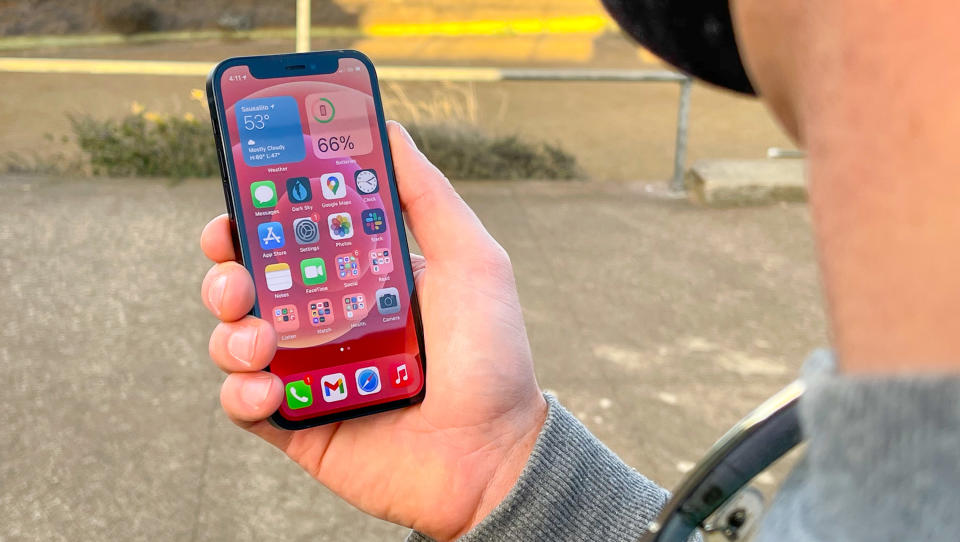
That's not the case here. The iPhone 12 mini is, by far, the most powerful small phone I've tested in years. I should note, though, that like the standard iPhone 12, the mini packs 4GB of RAM; for comparison, the 12 Pro comes with 6GB. I haven't noticed a significant difference in day-to-day performance, but that extra memory should give the Pros an edge when you’re jumping between multiple apps. Personally, I wouldn't sweat it much: The mini offers sufficient power for just about everything, with enough overhead to stave off obsolescence.
This is also one of Apple's first 5G phones, with full support for the sub-6 and mmWave networks that are sprouting up around you. 5G is a lot more common now than it was this time last year, but for the most part, you won't notice a dramatic difference in network performance.
That won't be true for everyone, though: If you live in a place where T-Mobile has lit up its mid-band 5G, you should notice some improvements, and you could see some insane speeds if you stop on a street corner where Verizon's mmWave 5G is available. At this point, I have to note that Verizon owns Engadget but has no editorial control over us, so I can say mmWave — while technically very cool — is meaningless to a lot of people right now.
The 12 mini also plays nice with Apple's various MagSafe accessories, including a new one we haven't tried yet: a sleek leather pouch with a cutout allowing you to easily check the time. That might not sound super interesting, but there's more to it than you think. When the phone can tell it's been slipped into the case, its screen changes color to match the case when you tap it to check the time.
It's a brilliant little touch, but I think Apple missed an opportunity here. See, when you check the time through the cutout, the entire screen lights up. That doesn't sound like a big deal, but since Apple's Super Retina XDR display is technically an OLED, the better move for battery life would have been to only light up the part of the screen visible through the hole. Who knows, maybe they'll fix that in a software update.
On Apple's website, the company notes that the iPhone 12 mini is limited to 12W wireless charging, compared to 15W charging for the rest of the iPhone 12 line. Yes, that's still faster than standard Qi wireless charging, but it's potentially a bummer for anyone thinking of going all-in on MagSafe. Apple wouldn't specifically comment on the limitation but honestly, you should really just plug your phone in anyway.
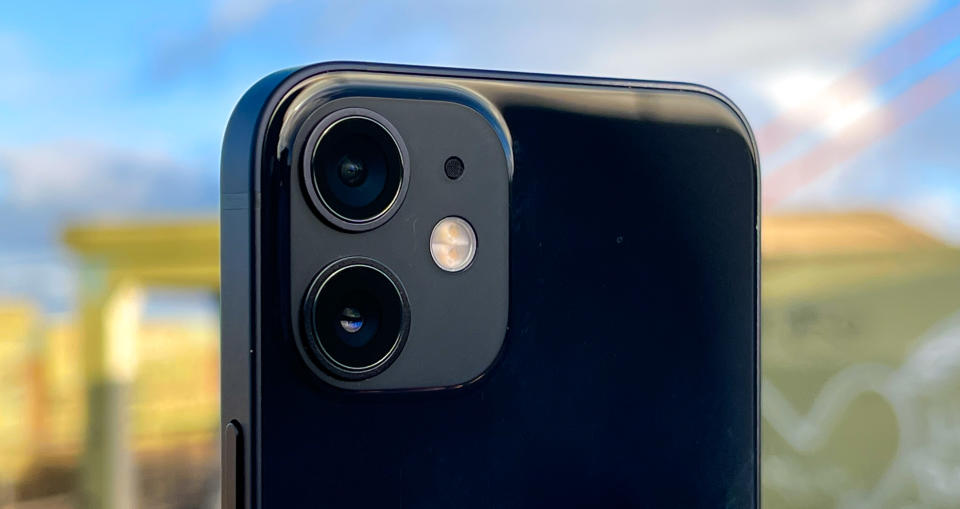
Camera performance
As for the cameras, this is the same setup as the iPhone 12: There’s a 12-megapixel wide camera with an f/1.6 aperture, optical image stabilization and a new, 7-element lens, plus a 12-megapixel ultra-wide camera that can capture a 120-degree field of view. It's important to note that optically, these sensors and lens setups aren't that different from last year’s. The main camera still produces the best images, and it's slightly better in low light thanks to a wider aperture, though again, you won’t necessarily see a huge change, especially since Night Mode is so quick to activate.
And the ultrawide? Well, it's still a bit of a niche tool, and its images remain notably softer than what you'd get from the main camera. That's just how it goes, though: Ultra-wide cameras have always been more about capturing space than detail, and this sensor's 120-degree field of view makes for some fantastic landscapes.
But camera hardware is only part of the story. Apple also changed the way it processes images. Photos you take with the main camera are more detailed than last year's iPhones, and improvements to Apple's Smart HDR mean the 12 mini is better at identifying what's going on in a scene and tweaking the resulting image accordingly. For the most part, that means photos look warmer and punchier than before — apart from skies, which take on a brighter blue tone. Those improvements also carry over to the ultra-wide camera, which is also now better at ironing out image distortion. It's definitely still there, though: Try taking an ultra-wide landscape with people on the edges, and you'll see what I mean.
As always, it's hard to proclaim which smartphone takes the best pictures; it's all subjective, especially when you consider the different vibes smartphone makers strive for when tuning their camera software. If you're a fan of moody, higher-contrast photos, the Pixel 5 might be more your speed. If hyper-aggressive colors appeal, there are devices like the Galaxy S20 FE. Overall, the iPhone 12 mini takes lovely photos that split the difference between those two extremes.
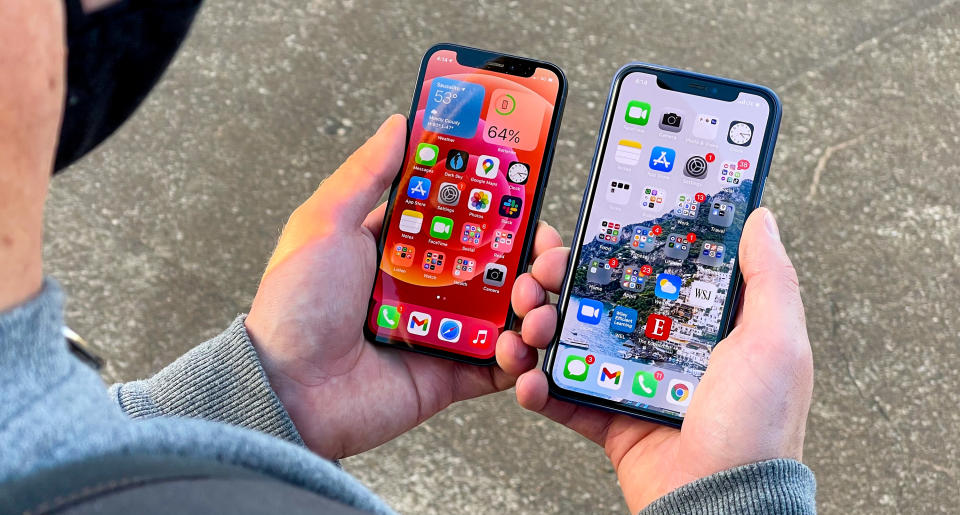
The mini difference
Everything we've just gone through makes this the most capable small smartphone I've tested in years, but does that mean you should buy one? Ultimately, I think whether the 12 mini makes sense for you boils down to two things: the smaller design and battery life.
As far as the 12 mini's size is concerned, Apple did a great job here. I was already a fan of the flatter, more angular iPad Pro-inspired aesthetic the company brought to this year’s iPhones, and it works just as well now that Apple shrank it down. The fit and finish are also first-rate, and I can't think of another small phone that feels as well-built as this. I know some people aren't fans of how light the iPhone 12 series is, and I get that, but if you were thinking of buying a small phone, weight was likely already a concern.
I know I've been calling the iPhone 12 mini a small phone, and that's objectively true — it's even a bit smaller than the iPhone SE I reviewed earlier this year, but a few trusted people to whom I've shown the phone didn't think it was that small. That's largely thanks to the 12 mini's 5.4-inch Super Retina XDR display. It's just as bright as the standard iPhone 12 and packs the same support for wide-color gamuts and HDR, but because it's smaller, it's more pixel-dense. While bigger phones are almost always better for immersiveness, this screen never felt too small.
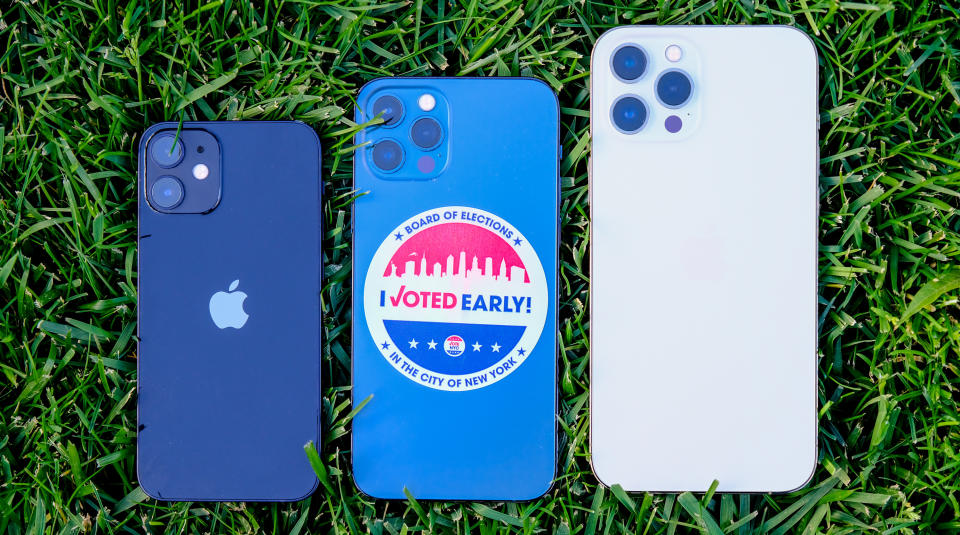
And I’ll be honest: “too little” was a big concern for me going into this review. When I tried the iPhone SE earlier this year, I found its 4.7-inch screen tough to adjust to after years of reviewing huge smartphones. Typing, in particular, was a pain at first, since I had to relearn how to type on such a small screen. Thankfully, none of that was true with the 12 mini. There’s a learning curve, sure, but nothing outrageous.
As a small-phone convert, I can't overstate how much I like the iPhone 12 mini — it strikes a good balance between size and performance. But I can’t pretend it doesn’t have its issues, the biggest of which you probably saw coming. In short, the iPhone 12 mini’s battery life is adequate at best, and that’s being pretty generous. It is absolutely the kind of phone you’ll have to charge every night, if not sooner.
I said earlier that I’m spending nearly all my time at home, but not everyone can do that. Maybe you’re an essential worker who still has to go to work every day. Maybe you live somewhere where you feel safe spending lots of time outside your home. Or maybe sometimes you have to travel somewhere.
That was me recently, and I spent most of that travel day wondering whether the phone would last til the evening. Sure enough, on my first day of using the 12 mini as my daily driver, I pulled it off the charger at 8AM and it was on its last legs by 4PM. Mind you, iOS reported about seven hours of screen-on time, but I wasn’t doing anything crazy like watching videos or playing games; it was all doom-scrolling in Safari and on Twitter, with some Spotify music and podcasts to keep me sane.
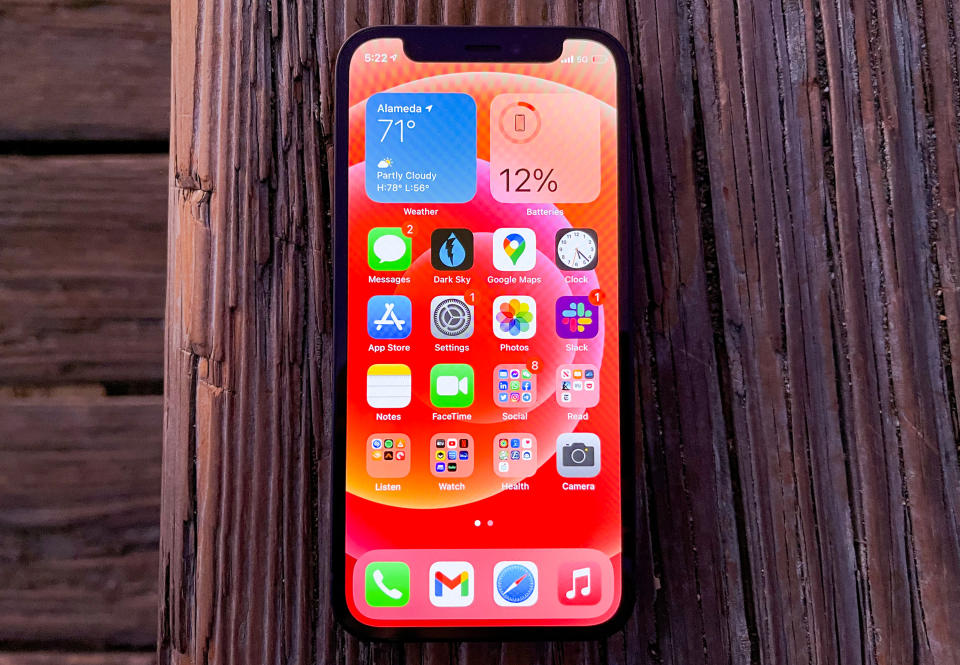
During more typical days at home, where my attention was split between my computer and my phone, the 12 mini did a little better. On average, I was looking at 12 to 13 hours of on-and-off use. That’s about on par with what I saw from the iPhone SE earlier this year, but that wasn’t particularly impressive either. The only thing that made it somewhat acceptable was the fact that the SE costs $400. Right now, I could make the mini's battery work for me, but when the world re-opens and I spend more of my time out of the house? I could make it a point to carry around a power bank; lots of people already do just that. Maybe I'm just spoiled by big devices with big batteries, but once you stop worrying about how long your phone will last, you never want to go back.
Another reason I can’t fully get on board with this thing is that it sits in a strange place in Apple’s iPhone lineup. At $699, this is the cheapest version of the iPhone 12 the company makes, but last year you could get a phone with a bigger screen and much better battery life for the same price.
Framed as a budgeting decision, this is the most accessible of Apple’s newest iPhones, but that doesn’t mean it’s going to make sense for most people. And despite the 12 mini's improved performance and better screen, I'd still probably recommend that shoppers who don't want to drop $800-plus on a phone consider last year's iPhone 11 instead. You could nab one of those with 128GB of storage for about $650 right now, which is $50 to $80 less than the base level iPhone 12 mini with 64GB of storage depending on where you buy it.
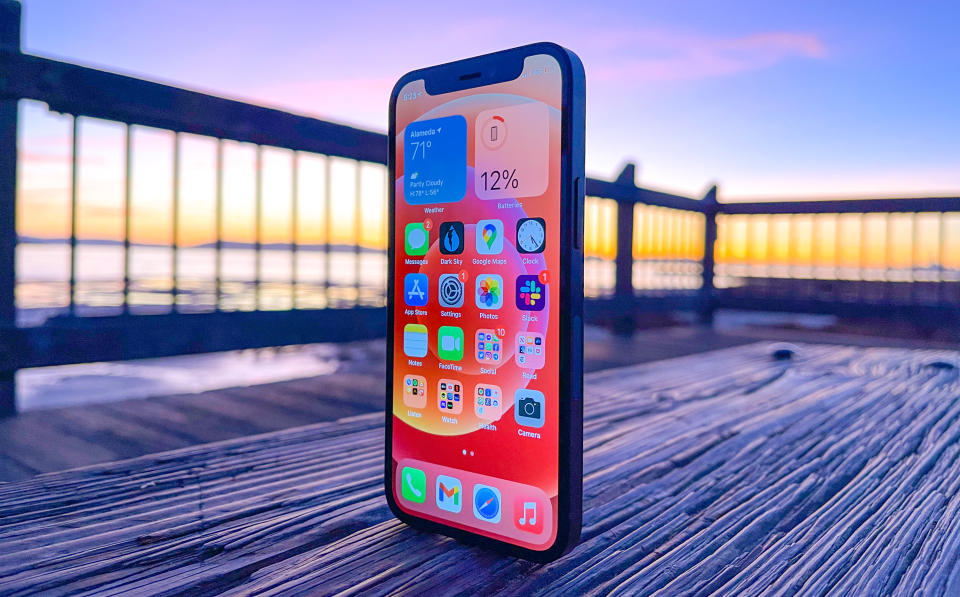
Wrap-up
The iPhone 12 mini has a lot going for it, and people who want a smaller phone will be hard-pressed to find a device that’s as powerful and as well-built as this one. As for me, I'm of two minds. I have sincerely enjoyed using a small phone again, especially one this capable. There were even a few moments when I considered going all-in on the iPhone 12 mini as my daily driver — until I started seeing how quickly the battery drains. As I said earlier, there are ways to manage that issue, but that can be a big — and unwelcome — ask for some people.

